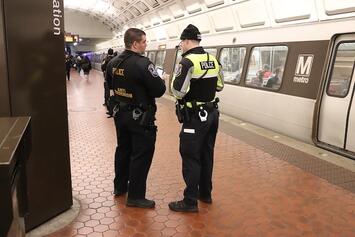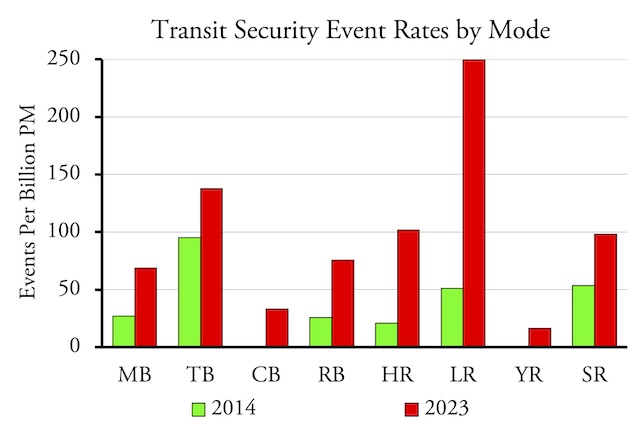
Less than half of New York City residents feel safe riding the subway today, down from 82 percent before the pandemic. Subway crime is so bad that New York’s governor called out the national guard to patrol subway stations. Crime is up on San Francisco BART trains despite the agency putting more police on trains. A few days ago, a mentally ill person stabbed someone to death on a Portland light-rail train.
Will putting more police in subway stations solve the crime problem? Probably not if BART’s experience is any guide.
Some people say transit crime is dropping so it’s safe to ride transit. Others say it is getting worse. Who’s right? We can get some answers from the Federal Transit Administration’s Major Safety Events Database, which was recently updated with data through the end of 2023.
The database lists more than 88,000 safety and security events since 2014. Safety events include things like collisions between transit vehicles and other vehicles. Security events include assaults and murders. The database counts suicides as security events, but I think they reflect safety problems and have adjusted the data to account for this. Suicides appear to be way down since the pandemic, possibly because transit agencies have stopped blaming accidental fatalities on suicides.
The database does not include commuter rail as apparently that mode is monitored by the Federal Railroad Administration. Crime rates on commuter buses are much lower than other buses and it is likely that crime rates on commuter rail are similarly low.
Some other security events are also not crimes. If someone accidentally leaves a backpack on bus or train, transit police may decide to evacuate the vehicle in case the backpack contains a bomb. The event gets written up even if the backpack turns out to be innocent. Rather than go through all 88,646 events recorded in the database, I’m going to assume that such innocent events are distributed equally among all agencies and modes. If true, then the crime rates reported below will be a little higher than the truth, but the relative rates between cities and mode will be about the same.

Modes of transit that collect fares using the honor system tend to have the greatest security risks for passengers. MB=conventional bus; TB, CB, & RB are trolley, commuter, and rapid bus; YR is hybrid rail meaning Diesel-powered light rail; SR=streetcars.
In recent years, heavy rail has seen far more security problems than any other mode of transit. But heavy rail also carries far more riders than any other mode except conventional buses. To assess the risk people take when riding various transit systems, I’ve calculated the number of safety or security events per billion passenger-miles. Passenger-miles from 2014 through 2022 are in the National Transit Database historic time series, table TS2.1. For 2023, I estimated passenger-miles by multiplying the average trip length in 2022 (passenger-miles divided by trips) by the number of trips in 2023.
I last reviewed transit security in 2022 using data through 2021. The most recent data show that transit crimes, per billion passenger-miles, have slightly dropped from 2021, but are still worse than from before the pandemic. However, crime rates were already growing before the pandemic began, meaning that crime rates today are much worse than in 2014.
Not counting suicides, bus and rail riders suffered an average of 274 crimes and 0.3 murders per billion passenger-miles in 2014. This rose to 431 crimes and 1.6 murders per billion in 2019, then leapt to 1,046 crimes and 4.9 murders in 2021, declining to 781 crimes and 2.9 murders in 2023. The 2023 numbers make transit look safe compared with 2021, but transit riders were still almost three times more likely to be crime victims and ten times more likely to be killed in 2023 than in 2014.
The highest crime rates are on light rail, streetcars, and trolley buses. Light rail and streetcars both collect fares using the honor system, and the broken windows hypothesis suggests that making it easy to evade fares invites more crime. Trolley buses are only found in a few cities and crime rates on this mode are skewed by high rates in San Francisco, which also collects fares using the honor system on its trolley buses. It is worth noting that many cities are addressing transit crime on heavy rail by installing better fare gates and St. Louis is planning to install such gates for its light-rail system.
Read the rest of this piece at The Antiplanner.
Randal O'Toole, the Antiplanner, is a policy analyst with nearly 50 years of experience reviewing transportation and land-use plans and the author of The Best-Laid Plans: How Government Planning Harms Your Quality of Life, Your Pocketbook, and Your Future.
Photo: Elvert Barnes, via Flickr under CC 2.0 License.












